Highscreen Boost 2 SE smartphone review: bug fixes with Qualcomm Snapdragon 400
Highscreen Boost 2, released last fall, left a mixed impression on me. On the one hand, without reservation, a record battery of 6,000 mAh, on the other hand, is far from the most advanced in terms of energy consumption of Qualcomm 8225Q by 45 nm process technology. Highscreen Boost 2 SE, which appeared in February this year, became a full-fledged work on bugs. In fact, only the previous case was left, but the batteries, otherwise the filling has almost completely changed. In my opinion, the most remarkable moment was the installation of the Qualcomm Snapdragon 400 MSM8228 processor. Because it is a) whatever one may say, not MediaTek b) 28 nm process technology c) not the most budgetary and quite fresh model. And paired with 2 GB of RAM, such a processor looks great.
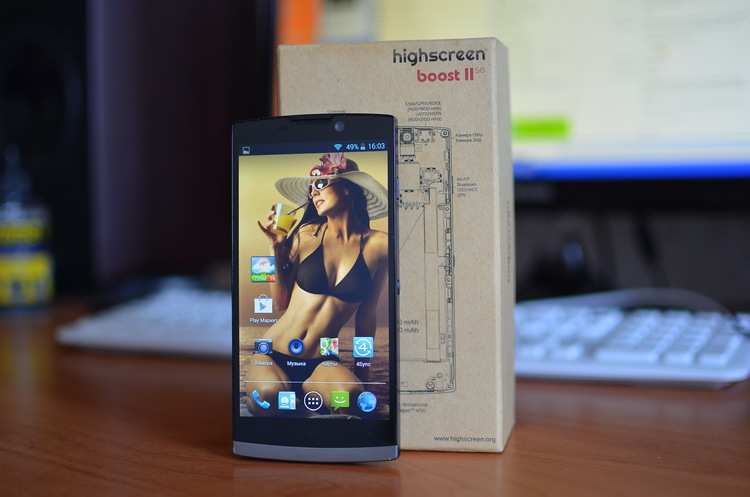
Perhaps, before the main story, I’ll briefly recall the main changes compared to Highscreen Boost 2. Instead of a “solo” GPS, a hybrid GPS / GLONASS receiver arrived, an 8 megapixel camera was replaced with 13 megapixels, the ROM volume increased from 4 GB to 8 GB, Android “matured "To version 4.3, and the screen matrix was changed to that of Sharp. Together with the above-mentioned processor and the amount of RAM, it turned out, to put it mildly, an interesting machine. True, the price has risen - if Highscreen Boost 2 costs 10,990 rubles (~ $ 314), then Highscreen Boost 2 SE will cost 12,490 rubles (~ $ 356).
If you read a review of at least one Highscreen smartphone, you can imagine what cardboard the Highscreen Boost 2 SE box is made of and what is shown on the front side. After almost a year of such a “tradition”, I would like to see at least some kind of diversity. Although the minimalism of information and eco-friendly cardboard still look more interesting than the same pasting of most current smartphones. As I understand it, at the time of the start of production Highscreen really was going to give us the usual 20 GB in the 4Sync “cloud”, but in the end it got generous with 64 GB. By the way, 100 GB on 4Sync cost $ 10 per month, the same amount for the same space requires Dropbox.
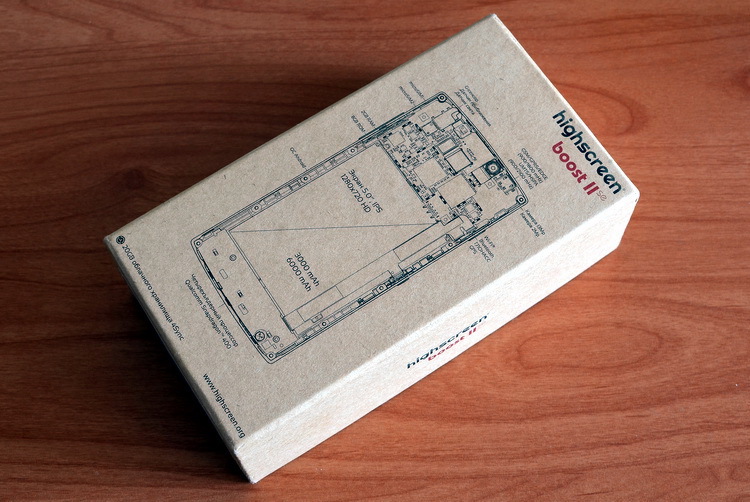
The box contains a warranty card, instructions, microUSB cable, network charging unit and a headset. I recommend replacing the latter immediately, unless you dislike the low frequencies. Of course, the covers in the kit are not one, but two, according to the number of batteries. I just had Highscreen Boost 2 at hand, so I made sure the interchangeability of the smartphone panels. Moreover, the batteries can be changed in the same way, I did not observe any problems when installing a non-native battery in the bowels of Highscreen Boost 2 SE.
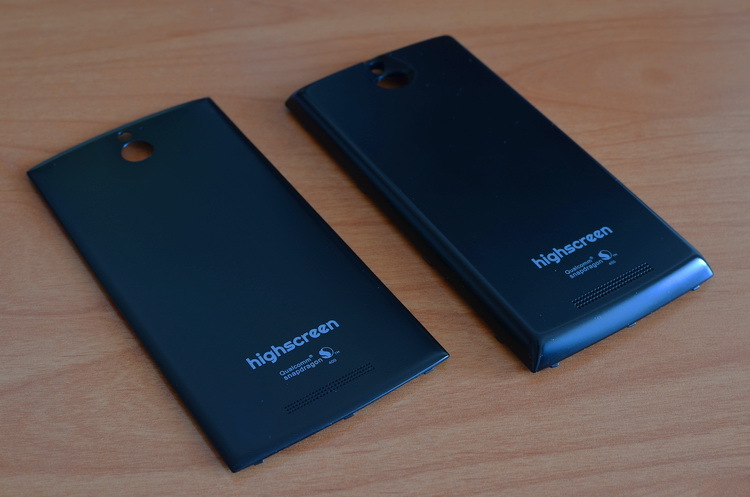
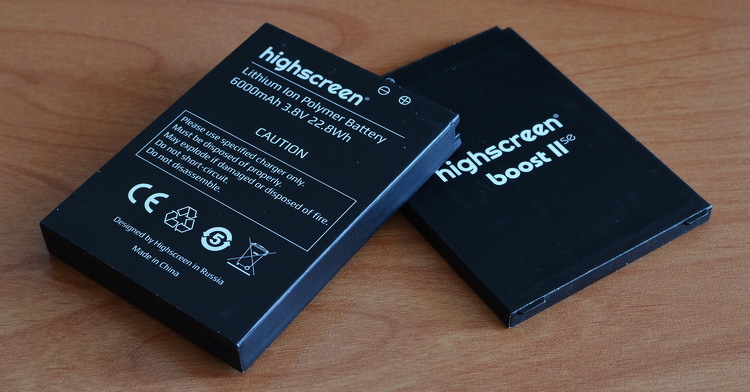
As I said, the case of the model remains the same. Only a few details were added - the panel under the display turned gray, and an inscription appeared on the back cover indicating the installed processor. I don’t know how other observers and users, but I liked the gray insert, the smartphone looks much more interesting against the background of the absolutely black (and boring) Highscreen Boost 2, and the vast majority of current smartphones. Another question is that you need to handle the model carefully, because the problem of erasing faces has not gone away. I myself did not even suspect such a moment, thanks to monitorika comrade for interesting information . By the way, the panel is made of metal, I found out at least on the slightly worn out (or “polished”) left side.
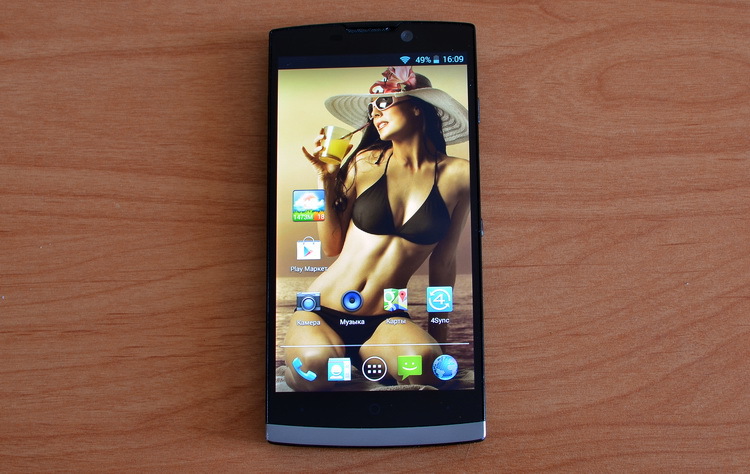
Overall dimensions in comparison with the “original” have not changed one iota. With a 3,000 mAh battery, we see 68.6 x 140 x 9.8 mm and 151 grams of weight, with 6,000 mAh - 68.6 x 140 x 14.8 mm and 203 grams. If we talk about subjective impressions, I liked the ergonomics of the model. With a smaller battery, the smartphone is not too heavy and even looks thin. Although I really remembered about really thin smartphones as soon as a fresh Highscreen Thor arrived to me. As a positive point, I note the moderate height of the case - with a grip that is convenient for me, out of the finger’s access no more than 15% of the screen area remains.
The opinion that I have regarding the design of Highscreen Boost 2 is entirely relevant for his successor. The shape of the speech speaker, the rounded top and bottom along with the insert under the display make the device's appearance a little more diverse in comparison with more or less the same type of smartphones of the second-tier brands. Further depends on the installed battery. At 3,000 mAh, the smartphone looks pretty good - these are clearly the terrifying “bricks” that B-brands offered us from a year ago.
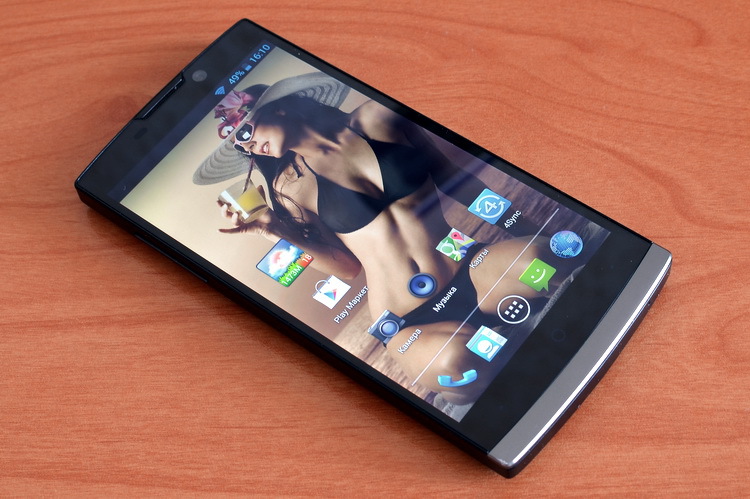

With the installation of a 6,000 mAh battery, the smartphone becomes ugly, the complete absence of rounding at the joints of the lid did not benefit the model in terms of the exterior, or the convenience of holding it in the palm of your hand. By the way, the “arrangement” in terms of build quality also remained at the level of its predecessor - there are no questions about the “thin” version, but with a large lid there are creaks and backlashes.
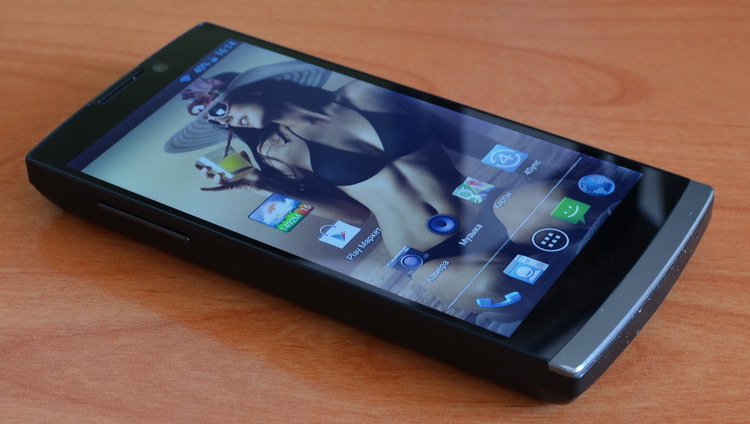
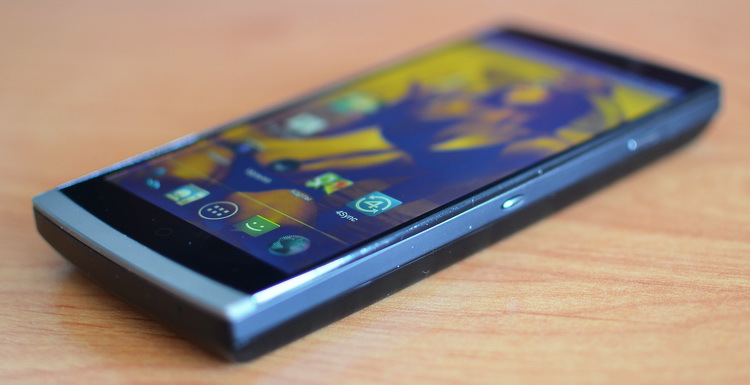
Now let's take a closer look at the exterior of the device. On the front side - light and proximity sensors, a camera, a speech speaker - everything is standard.

The touch panel below the screen is still devoid of boring Android icons, instead of them there are glowing dots on the sides and a circle in the center. The same circle successfully replaces the event indicator and starts to blink with a new SMS or letter. The low brightness came to my taste, because if there is no time / desire to be distracted by a smartphone, even with the model in front of my eyes, blinking does not distract or irritate.

A set of volume and power keys is diluted with the multifunction button "at the equator" on the left side. We will talk about it in more detail later.

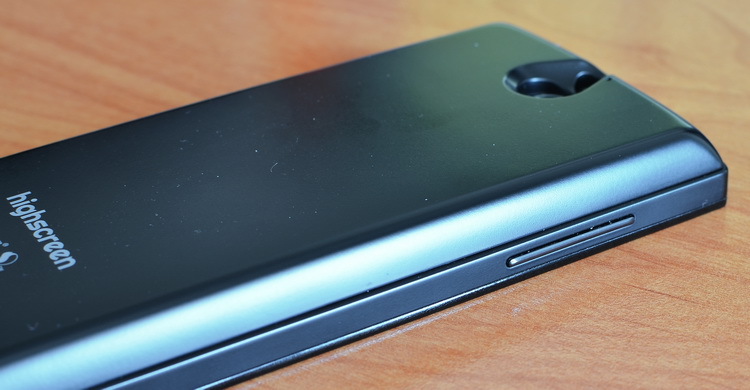
The microUSB connector and audio output are where they are supposed to be - at the top.
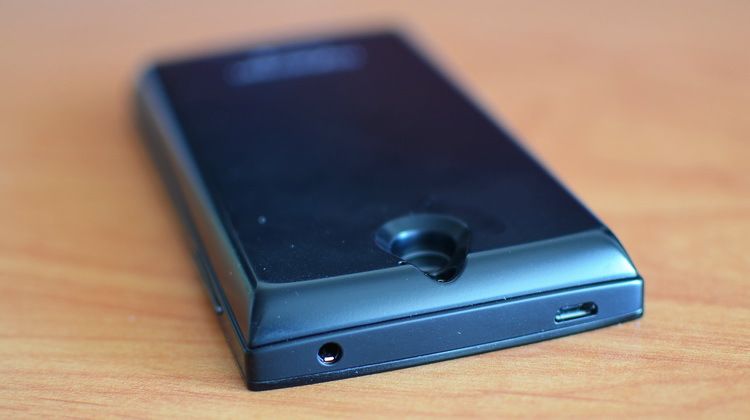
On the back, we admire the words “Qualcomm snapdragon 400”, which I personally like much more than the signatures of the number of megapixels next to the camera. Moreover, megapixels say almost nothing about the quality of shooting, and the processor model very eloquently testifies to the performance of the smartphone.

Under the cover are located for microSIM slot and one for microSD card.
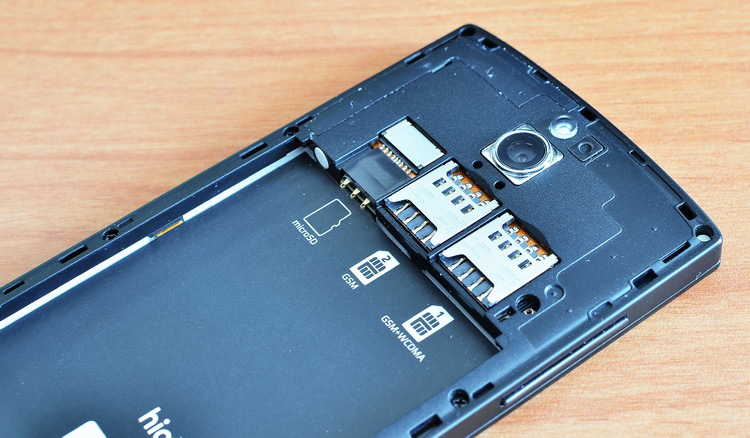
Highscreen Boost 2 SE retained the main parameters of its predecessor - 5 inches, a resolution of 1280 x 720 pixels and, accordingly, 294 PPI. I am not a fan of looking for pixelation in HD displays, and I am not a priori inclined to consider them to be the least compromise for the sole reason that mobile Full HD screens exist. In general, I consider the Highscreen Boost 2 SE resolution to be the “golden mean” between the really noticeable grit qHD and the differences that are not very noticeable to the eye with the more expensive Full HD options.
This time, the Japanese manufacturer of the screen was Sharp, which provided the display with relevant technologies such as OGS and Full Lamination. In terms of maximum brightness, the novelty still loses Highscreen Boost 2. But it is noticeably ahead in detail and correct color reproduction. The black color in Highscreen Boost 2 SE looks deeper, there are questions to white in both models. Highscreen Boost 2 SE has an orange tint, while Highscreen Boost 2 has a blue eye.
Nevertheless, Highscreen Boost 2 SE is in a better position, because in the settings it allows you to adjust the color rendering of the screen. There are presets “standard” and “bright” plus four parameters for manual adjustment. The viewing angles of the models are approximately equal. However, Highscreen Boost 2 SE got rid of the blue and orange “plaque”, which were too noticeable when looking diagonally in Highscreen Boost 2.
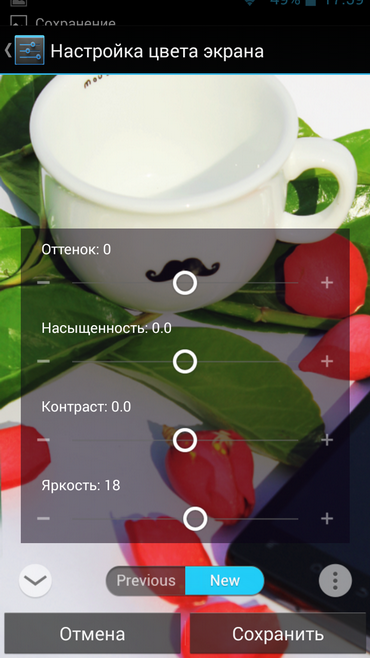
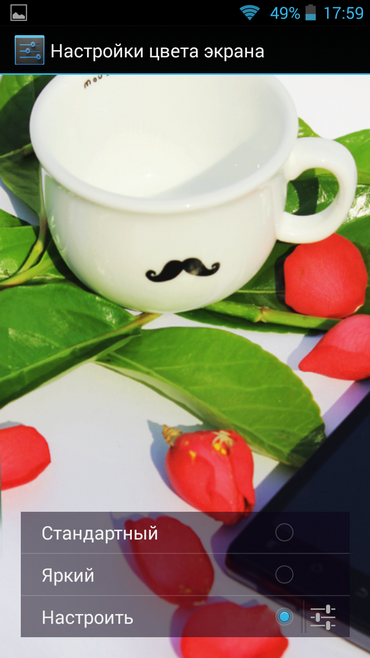
I’m somehow used to capacious batteries, so the hardware component has become for me the most interesting part of the smartphone. Many B-brands in the specifications indicate the presence of a 4-core processor and bashfully hide its manufacturer - MediaTek. Highscreen Boost 2 SE is notable for the fact that instead of MediaTek it uses the “heart” from Qualcomm. It would seem that nothing unusual - the same Qualcomm MSM8225Q is installed in many models of the brand. However, Qualcomm MSM8225Q is, in fact, the most budget solution of the not-so-fresh Play line, and even with the frankly outdated Adreno 203. The Quad-core Qualcomm Snapdragon 400 is in Highscreen Boost 2 SE. This processor was first introduced a year ago, the press the release of the complete readiness of the chipset appeared in June. At the moment, according to Yandex.Market, Highscreen Boost 2 SE is the only smartphone with Qualcomm Snapdragon 400 MSM8228. Yes, the list includes Huawei Ascend G6 4G, but it is still being prepared for release.
Qualcomm Snapdragon 400 MSM8228 has four cores ARM Cortex A7 with a frequency of 1.4 GHz. The graphics chip is pretty good - Adreno 305 with support for OpenGL ES 3.0, DirectX, OpenCL, Renderscript Compute and FlexRender. Completes the picture of 2 GB of RAM. In general, the hardware of Highscreen Boost 2 SE turned out to be the envy of competitors, primarily - all kinds of options based on MediaTek MT6589. From words to action, we study the results in benchmarks. Basically, a wide audience likes to evaluate performance by AnTuTu Benchmark, in which the smartphone scored decent almost 20,000 points. In graphic tests, everything also looks rosy, without a single frame of 60 FPS in Epic Citadel - a clear confirmation of this.
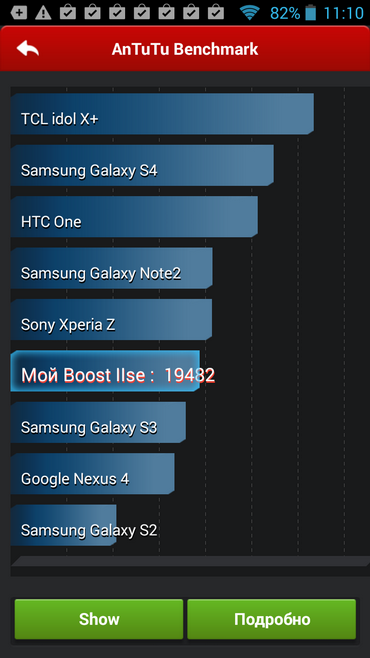
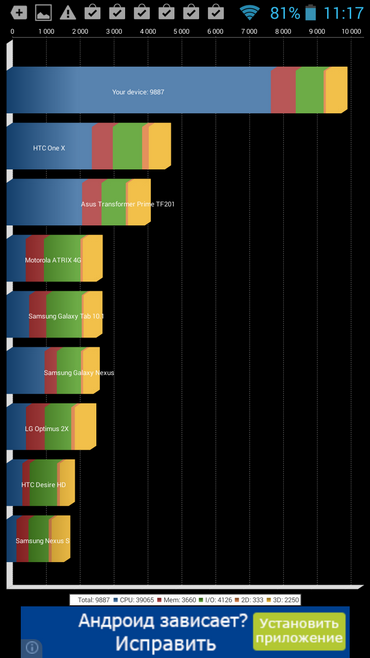

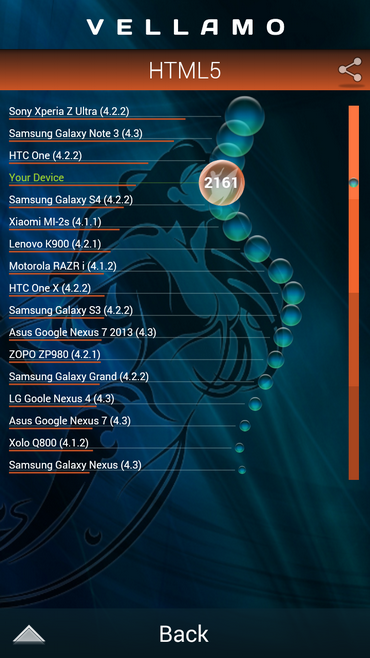
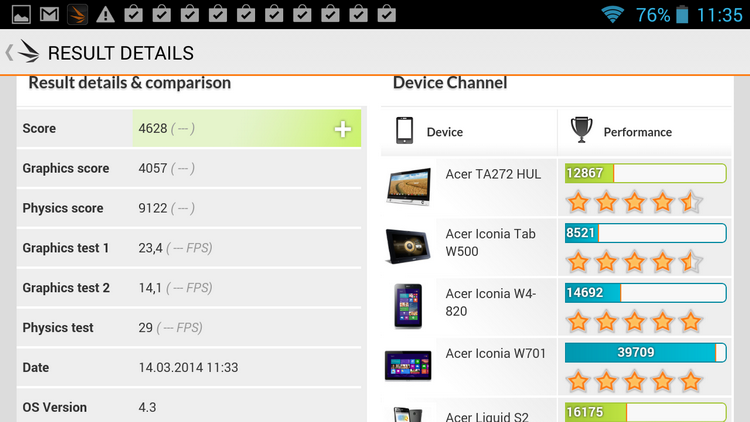

There were no problems with video playback, the smartphone “smoothly” launched flesh videos up to Full HD 60 fps. Unfortunately, it did not work out with 4k - none of the IXBT test suite files started up. However, watching 4k video on an HD screen seems to me a very strange activity. What I liked most about Highscreen Boost 2 SE is its gaming behavior. I was already tired of the compromises of MediaTek 6589, which even considers the confrontation of zombies and plants with a full HD screen a resource-intensive task, and you can’t call an omnivorous chipset with HD displays.
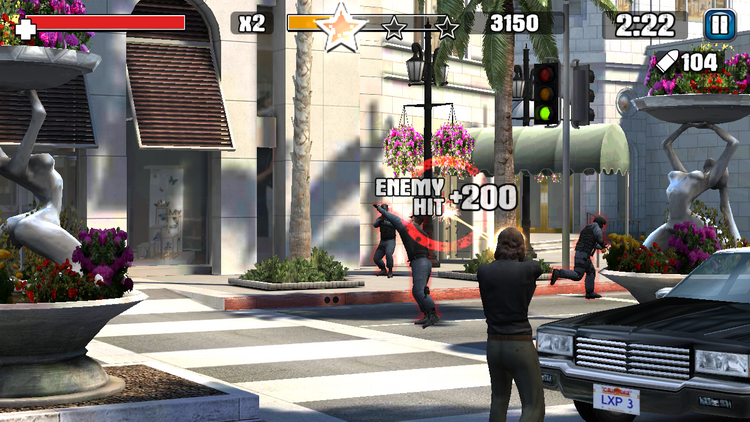
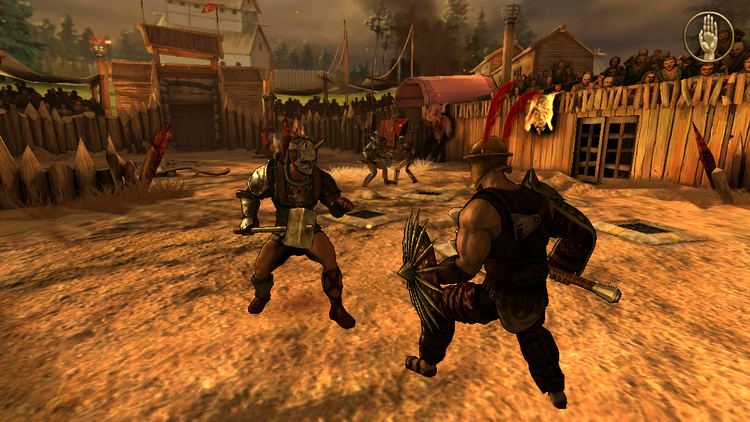
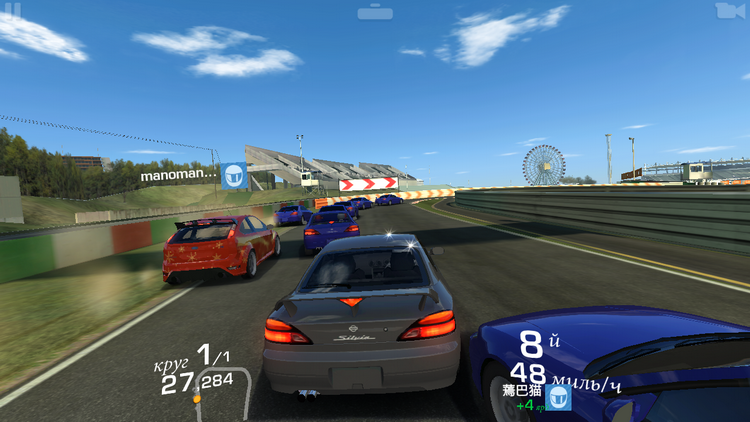
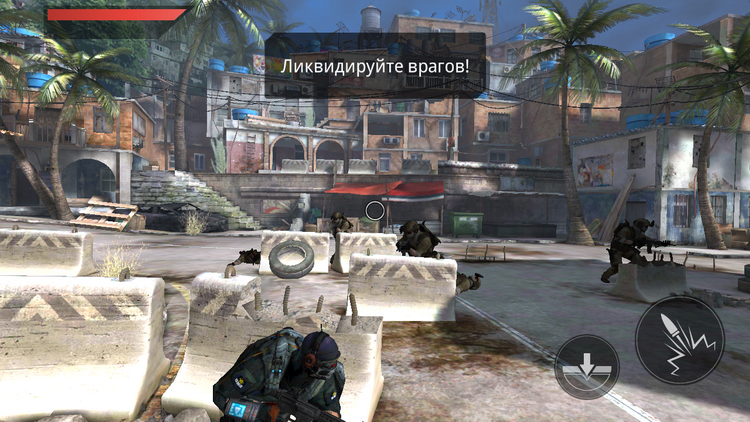
In contrast, the Highscreen Boost 2 SE with the Qualcomm Snapdragon 400 performed very well. This applies to the game "Iron Man 3", which likes to turn into a benchmark directly in the menu, and the high-poly Real Racing 3. And other titles, including those with the ability to set the maximum graphics settings - as in Riptide GP2 or Dead Trigger 2. I consider it a big plus lack of microlags when effects such as explosions, smoke, dust, etc. appear in the frame. - Highscreen Boost 2 SE does not fall into thoughtfulness for a split second to manage to load new elements of the scene.
From the front, the Highscreen Boost 2 SE has a 2 megapixel module, from the rear - 13 megapixels. It is clear that it is not worth placing special photographic hopes on the front “eye”. Although he honestly fulfills his pair of megapixels, and for girls it is quite suitable as a handy mirror.
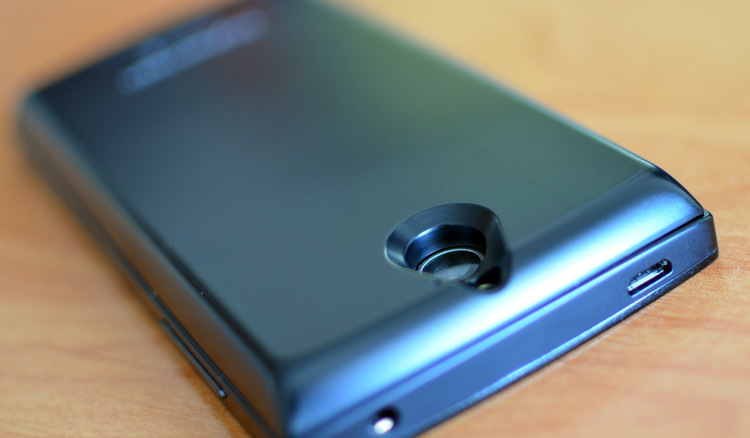
13 megapixels allow the camera to take pictures with a resolution of 4128 x 3096 pixels. However, a miracle did not happen - large numbers are again present rather for beauty. This is a problem not only of Highscreen Boost 2 SE, but without exception of all 13 megapixel B-brand smartphones that I have encountered. The quality of the photo does not exceed the 8 megapixel model, and most often noticeably inferior to them. I don’t know what the matter is - interpolation or corny cheap optics. However, the Highscreen Boost 2 SE camera, although I can not attribute it to the advantages, I will not record in minuses either. If only because the smartphone copes well with macro photography - if you like to photograph flowers in a clean field and insects, you will definitely like Highscreen Boost 2 SE. At medium and long distances, the camera lacks detail, and saturation has to be tweaked in the settings.


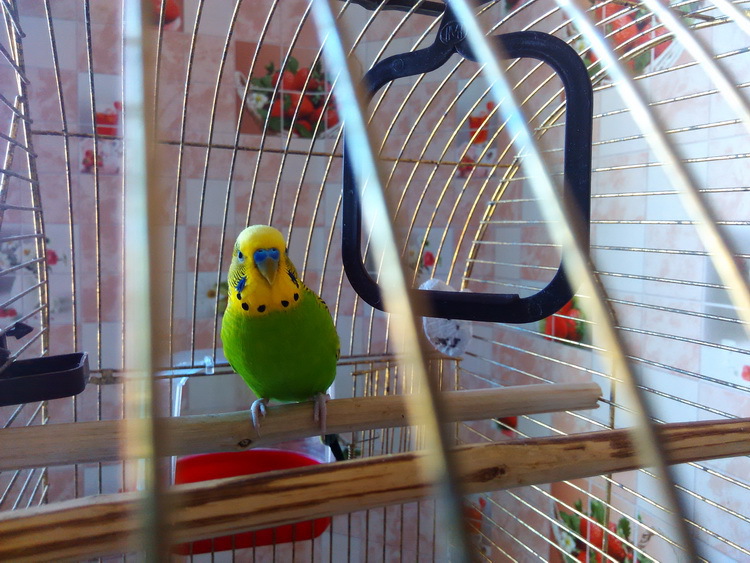
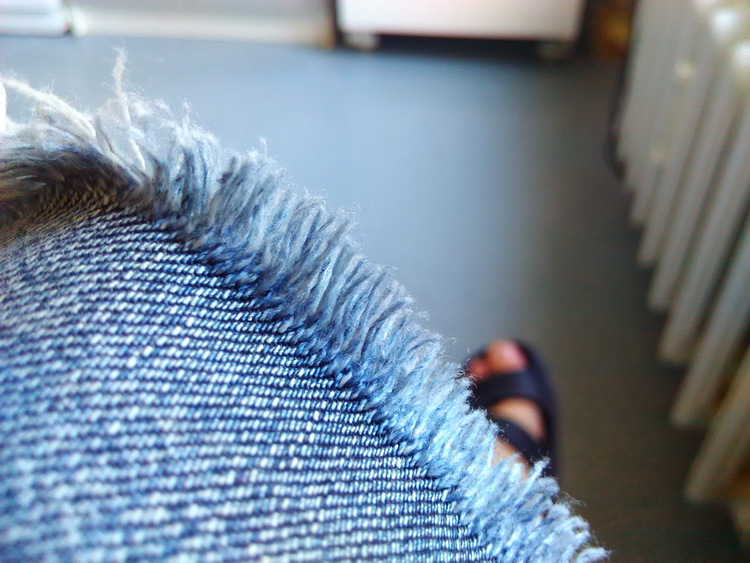
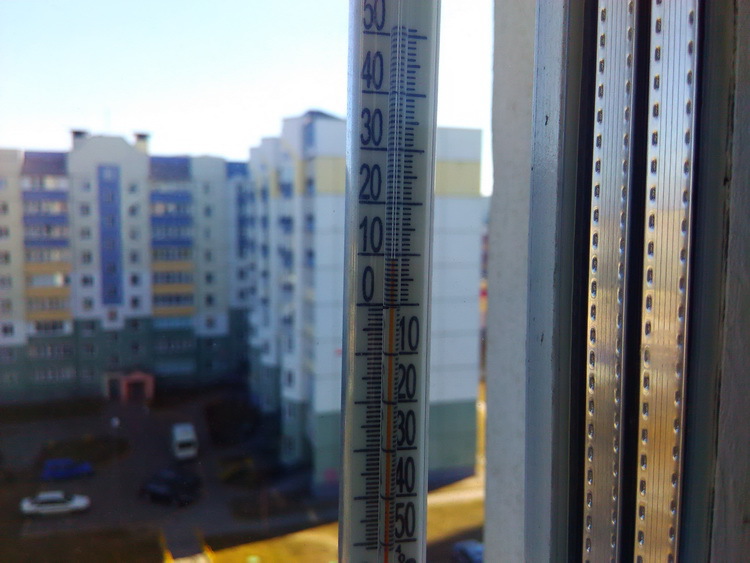
The shooting program is the moment when I regret the lack of a MediaTek chipset. Because the Taiwanese have a great shooting app, but Qualcomm doesn't. In Highscreen Boost 2 SE there is only a stock development of Android 4.3, and for some reason it has been fixed for the worse. Most of all, the list of options that is hidden behind three absolutely identical icons annoys me. Alternatively, with the constant use of Highscreen Boost 2 SE, I would recommend getting a more convenient shell from Google Play.
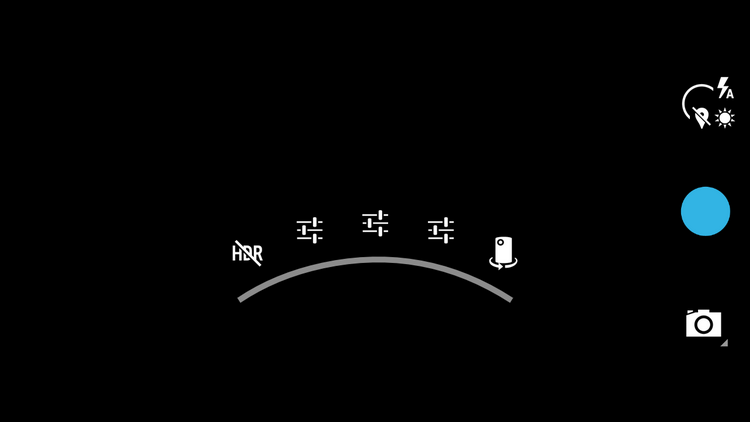

The shortest review point, because Highscreen again did not prepare any noticeable add-ons. But the Android version was pleased - 4.3, this release is not yet available on smartphones with MediaTek processors. I would like to describe the advantages of Android 4.3 over 4.2, but alas, I did not find any significant innovations, except that the information curtain has become more convenient. If you missed something - sorry, correct.
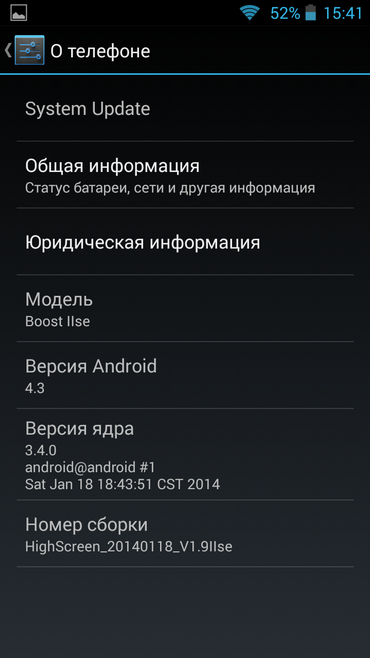
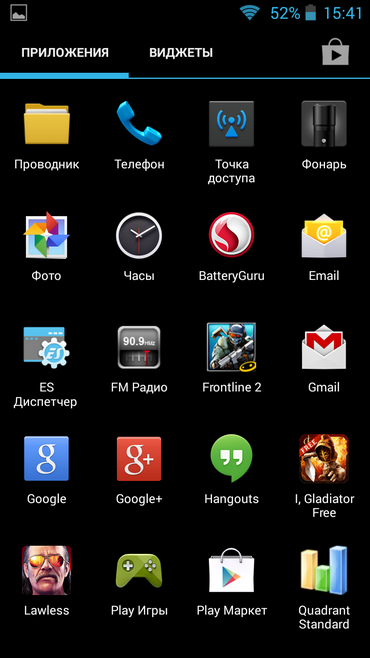

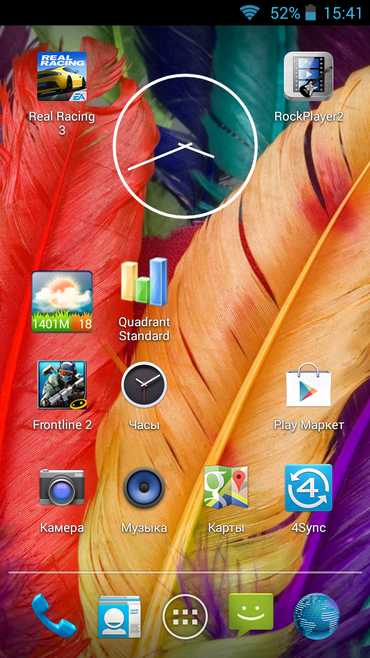
Finally, the multi-function button in Highscreen Boost 2 SE has become truly “versatile”. Let me remind you that in the previous model this key was limited to the appointment of only four tasks. Here, the quick start button allows you to choose from a complete list of installed programs in the system. Just in case - this functionality is introduced by the first “air” update of the smartphone, “out of the box” there are only a couple of points.

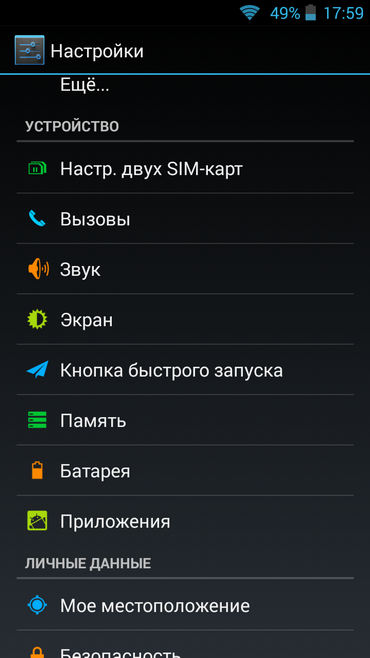
Highscreen Boost 2 SE truly revealed the potential of the 6,000 mAh battery, which is due to the more advanced 28 nm process technology. One of the main competitors of Highscreen Boost 2 at the time was called Lenovo P780, so I was not too lazy to compare the autonomy of the novelty and the Chinese device.
At maximum brightness in CoolReader:
HD video at maximum brightness and medium volume:
Epic Citadel at maximum brightness:
It should be assumed that higher performance has made itself felt when traveling across the expanses of Epic Citadel, so the difference between smartphones turned out to be insignificant. And here are the results in AnTuTu Tester. I think you will guess where the battery was measured.
Qualcomm BatteryGury is preinstalled for additional energy savings. This program monitors user activity for several days, after which, at its discretion, it automatically optimizes battery consumption. A set of four widgets is included.
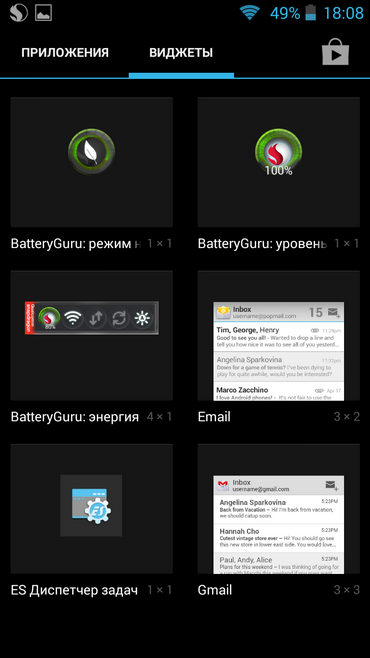
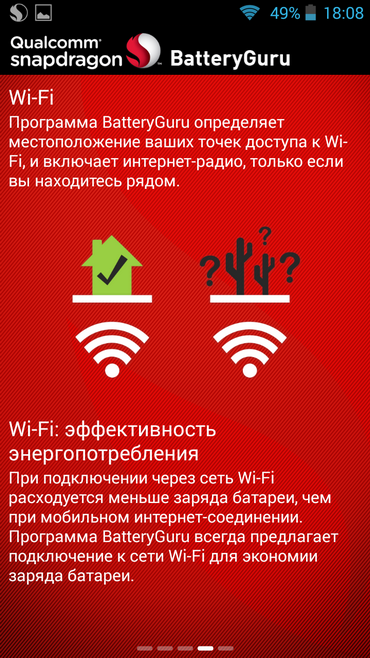
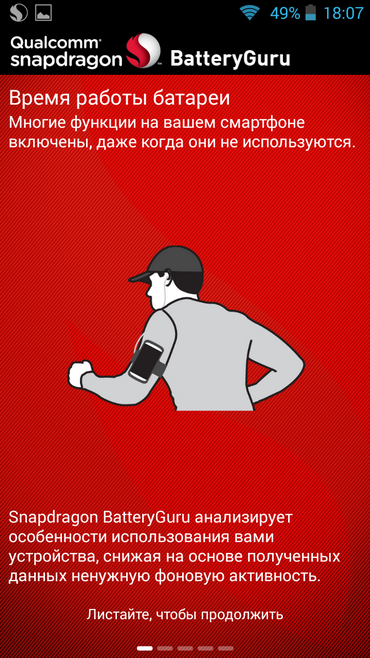

Perhaps this is the first Highscreen smartphone, which I seriously consider as a candidate for purchase. Highscreen Boost 2 SE didn’t have so many “sores” of its predecessor - a creaky back cover for a 6,000 mAh battery, a potentially erasable metal on the edges. That’s probably all. Fundamentally, two points have improved in the model. The first one is performance, I liked the new processor much more than the 4-core MediaTek, not least due to the better performance in games. The second point is autonomy, which added again due to the processor. We add here also a software add-on for optimizing energy consumption. The screen and camera have not critically improved, I would not consider these two points as motivating for choosing Highscreen Boost 2 SE instead of the previous model. Finally, as a pleasant bonus, do not forget about the hybrid GPS / GLONASS receiver. In general, Highscreen Boost 2 SE turned out to be at least an interesting smartphone among the new products already released this year.

Perhaps, before the main story, I’ll briefly recall the main changes compared to Highscreen Boost 2. Instead of a “solo” GPS, a hybrid GPS / GLONASS receiver arrived, an 8 megapixel camera was replaced with 13 megapixels, the ROM volume increased from 4 GB to 8 GB, Android “matured "To version 4.3, and the screen matrix was changed to that of Sharp. Together with the above-mentioned processor and the amount of RAM, it turned out, to put it mildly, an interesting machine. True, the price has risen - if Highscreen Boost 2 costs 10,990 rubles (~ $ 314), then Highscreen Boost 2 SE will cost 12,490 rubles (~ $ 356).
Equipment
If you read a review of at least one Highscreen smartphone, you can imagine what cardboard the Highscreen Boost 2 SE box is made of and what is shown on the front side. After almost a year of such a “tradition”, I would like to see at least some kind of diversity. Although the minimalism of information and eco-friendly cardboard still look more interesting than the same pasting of most current smartphones. As I understand it, at the time of the start of production Highscreen really was going to give us the usual 20 GB in the 4Sync “cloud”, but in the end it got generous with 64 GB. By the way, 100 GB on 4Sync cost $ 10 per month, the same amount for the same space requires Dropbox.

The box contains a warranty card, instructions, microUSB cable, network charging unit and a headset. I recommend replacing the latter immediately, unless you dislike the low frequencies. Of course, the covers in the kit are not one, but two, according to the number of batteries. I just had Highscreen Boost 2 at hand, so I made sure the interchangeability of the smartphone panels. Moreover, the batteries can be changed in the same way, I did not observe any problems when installing a non-native battery in the bowels of Highscreen Boost 2 SE.


Appearance and controls
As I said, the case of the model remains the same. Only a few details were added - the panel under the display turned gray, and an inscription appeared on the back cover indicating the installed processor. I don’t know how other observers and users, but I liked the gray insert, the smartphone looks much more interesting against the background of the absolutely black (and boring) Highscreen Boost 2, and the vast majority of current smartphones. Another question is that you need to handle the model carefully, because the problem of erasing faces has not gone away. I myself did not even suspect such a moment, thanks to monitorika comrade for interesting information . By the way, the panel is made of metal, I found out at least on the slightly worn out (or “polished”) left side.

Overall dimensions in comparison with the “original” have not changed one iota. With a 3,000 mAh battery, we see 68.6 x 140 x 9.8 mm and 151 grams of weight, with 6,000 mAh - 68.6 x 140 x 14.8 mm and 203 grams. If we talk about subjective impressions, I liked the ergonomics of the model. With a smaller battery, the smartphone is not too heavy and even looks thin. Although I really remembered about really thin smartphones as soon as a fresh Highscreen Thor arrived to me. As a positive point, I note the moderate height of the case - with a grip that is convenient for me, out of the finger’s access no more than 15% of the screen area remains.
The opinion that I have regarding the design of Highscreen Boost 2 is entirely relevant for his successor. The shape of the speech speaker, the rounded top and bottom along with the insert under the display make the device's appearance a little more diverse in comparison with more or less the same type of smartphones of the second-tier brands. Further depends on the installed battery. At 3,000 mAh, the smartphone looks pretty good - these are clearly the terrifying “bricks” that B-brands offered us from a year ago.


With the installation of a 6,000 mAh battery, the smartphone becomes ugly, the complete absence of rounding at the joints of the lid did not benefit the model in terms of the exterior, or the convenience of holding it in the palm of your hand. By the way, the “arrangement” in terms of build quality also remained at the level of its predecessor - there are no questions about the “thin” version, but with a large lid there are creaks and backlashes.


Now let's take a closer look at the exterior of the device. On the front side - light and proximity sensors, a camera, a speech speaker - everything is standard.

The touch panel below the screen is still devoid of boring Android icons, instead of them there are glowing dots on the sides and a circle in the center. The same circle successfully replaces the event indicator and starts to blink with a new SMS or letter. The low brightness came to my taste, because if there is no time / desire to be distracted by a smartphone, even with the model in front of my eyes, blinking does not distract or irritate.

A set of volume and power keys is diluted with the multifunction button "at the equator" on the left side. We will talk about it in more detail later.


The microUSB connector and audio output are where they are supposed to be - at the top.

On the back, we admire the words “Qualcomm snapdragon 400”, which I personally like much more than the signatures of the number of megapixels next to the camera. Moreover, megapixels say almost nothing about the quality of shooting, and the processor model very eloquently testifies to the performance of the smartphone.

Under the cover are located for microSIM slot and one for microSD card.

Screen
Highscreen Boost 2 SE retained the main parameters of its predecessor - 5 inches, a resolution of 1280 x 720 pixels and, accordingly, 294 PPI. I am not a fan of looking for pixelation in HD displays, and I am not a priori inclined to consider them to be the least compromise for the sole reason that mobile Full HD screens exist. In general, I consider the Highscreen Boost 2 SE resolution to be the “golden mean” between the really noticeable grit qHD and the differences that are not very noticeable to the eye with the more expensive Full HD options.
This time, the Japanese manufacturer of the screen was Sharp, which provided the display with relevant technologies such as OGS and Full Lamination. In terms of maximum brightness, the novelty still loses Highscreen Boost 2. But it is noticeably ahead in detail and correct color reproduction. The black color in Highscreen Boost 2 SE looks deeper, there are questions to white in both models. Highscreen Boost 2 SE has an orange tint, while Highscreen Boost 2 has a blue eye.
Nevertheless, Highscreen Boost 2 SE is in a better position, because in the settings it allows you to adjust the color rendering of the screen. There are presets “standard” and “bright” plus four parameters for manual adjustment. The viewing angles of the models are approximately equal. However, Highscreen Boost 2 SE got rid of the blue and orange “plaque”, which were too noticeable when looking diagonally in Highscreen Boost 2.


Performance
I’m somehow used to capacious batteries, so the hardware component has become for me the most interesting part of the smartphone. Many B-brands in the specifications indicate the presence of a 4-core processor and bashfully hide its manufacturer - MediaTek. Highscreen Boost 2 SE is notable for the fact that instead of MediaTek it uses the “heart” from Qualcomm. It would seem that nothing unusual - the same Qualcomm MSM8225Q is installed in many models of the brand. However, Qualcomm MSM8225Q is, in fact, the most budget solution of the not-so-fresh Play line, and even with the frankly outdated Adreno 203. The Quad-core Qualcomm Snapdragon 400 is in Highscreen Boost 2 SE. This processor was first introduced a year ago, the press the release of the complete readiness of the chipset appeared in June. At the moment, according to Yandex.Market, Highscreen Boost 2 SE is the only smartphone with Qualcomm Snapdragon 400 MSM8228. Yes, the list includes Huawei Ascend G6 4G, but it is still being prepared for release.
Qualcomm Snapdragon 400 MSM8228 has four cores ARM Cortex A7 with a frequency of 1.4 GHz. The graphics chip is pretty good - Adreno 305 with support for OpenGL ES 3.0, DirectX, OpenCL, Renderscript Compute and FlexRender. Completes the picture of 2 GB of RAM. In general, the hardware of Highscreen Boost 2 SE turned out to be the envy of competitors, primarily - all kinds of options based on MediaTek MT6589. From words to action, we study the results in benchmarks. Basically, a wide audience likes to evaluate performance by AnTuTu Benchmark, in which the smartphone scored decent almost 20,000 points. In graphic tests, everything also looks rosy, without a single frame of 60 FPS in Epic Citadel - a clear confirmation of this.






There were no problems with video playback, the smartphone “smoothly” launched flesh videos up to Full HD 60 fps. Unfortunately, it did not work out with 4k - none of the IXBT test suite files started up. However, watching 4k video on an HD screen seems to me a very strange activity. What I liked most about Highscreen Boost 2 SE is its gaming behavior. I was already tired of the compromises of MediaTek 6589, which even considers the confrontation of zombies and plants with a full HD screen a resource-intensive task, and you can’t call an omnivorous chipset with HD displays.




In contrast, the Highscreen Boost 2 SE with the Qualcomm Snapdragon 400 performed very well. This applies to the game "Iron Man 3", which likes to turn into a benchmark directly in the menu, and the high-poly Real Racing 3. And other titles, including those with the ability to set the maximum graphics settings - as in Riptide GP2 or Dead Trigger 2. I consider it a big plus lack of microlags when effects such as explosions, smoke, dust, etc. appear in the frame. - Highscreen Boost 2 SE does not fall into thoughtfulness for a split second to manage to load new elements of the scene.
Camera
From the front, the Highscreen Boost 2 SE has a 2 megapixel module, from the rear - 13 megapixels. It is clear that it is not worth placing special photographic hopes on the front “eye”. Although he honestly fulfills his pair of megapixels, and for girls it is quite suitable as a handy mirror.

13 megapixels allow the camera to take pictures with a resolution of 4128 x 3096 pixels. However, a miracle did not happen - large numbers are again present rather for beauty. This is a problem not only of Highscreen Boost 2 SE, but without exception of all 13 megapixel B-brand smartphones that I have encountered. The quality of the photo does not exceed the 8 megapixel model, and most often noticeably inferior to them. I don’t know what the matter is - interpolation or corny cheap optics. However, the Highscreen Boost 2 SE camera, although I can not attribute it to the advantages, I will not record in minuses either. If only because the smartphone copes well with macro photography - if you like to photograph flowers in a clean field and insects, you will definitely like Highscreen Boost 2 SE. At medium and long distances, the camera lacks detail, and saturation has to be tweaked in the settings.





The shooting program is the moment when I regret the lack of a MediaTek chipset. Because the Taiwanese have a great shooting app, but Qualcomm doesn't. In Highscreen Boost 2 SE there is only a stock development of Android 4.3, and for some reason it has been fixed for the worse. Most of all, the list of options that is hidden behind three absolutely identical icons annoys me. Alternatively, with the constant use of Highscreen Boost 2 SE, I would recommend getting a more convenient shell from Google Play.


System
The shortest review point, because Highscreen again did not prepare any noticeable add-ons. But the Android version was pleased - 4.3, this release is not yet available on smartphones with MediaTek processors. I would like to describe the advantages of Android 4.3 over 4.2, but alas, I did not find any significant innovations, except that the information curtain has become more convenient. If you missed something - sorry, correct.




Finally, the multi-function button in Highscreen Boost 2 SE has become truly “versatile”. Let me remind you that in the previous model this key was limited to the appointment of only four tasks. Here, the quick start button allows you to choose from a complete list of installed programs in the system. Just in case - this functionality is introduced by the first “air” update of the smartphone, “out of the box” there are only a couple of points.


Autonomy
Highscreen Boost 2 SE truly revealed the potential of the 6,000 mAh battery, which is due to the more advanced 28 nm process technology. One of the main competitors of Highscreen Boost 2 at the time was called Lenovo P780, so I was not too lazy to compare the autonomy of the novelty and the Chinese device.
At maximum brightness in CoolReader:
- Lenovo P780 - 14 hours 20 minutes;
- Highscreen Boost 2 SE - 20 hours.
HD video at maximum brightness and medium volume:
- Lenovo P780 - 5 hours 50 minutes;
- Highscreen Boost 2 SE - 9 hours 10 minutes.
Epic Citadel at maximum brightness:
- Lenovo P780 - 6 hours 30 minutes;
- Highscreen Boost 2 SE - 6 hours 50 minutes.
It should be assumed that higher performance has made itself felt when traveling across the expanses of Epic Citadel, so the difference between smartphones turned out to be insignificant. And here are the results in AnTuTu Tester. I think you will guess where the battery was measured.
Qualcomm BatteryGury is preinstalled for additional energy savings. This program monitors user activity for several days, after which, at its discretion, it automatically optimizes battery consumption. A set of four widgets is included.




Conclusion
Perhaps this is the first Highscreen smartphone, which I seriously consider as a candidate for purchase. Highscreen Boost 2 SE didn’t have so many “sores” of its predecessor - a creaky back cover for a 6,000 mAh battery, a potentially erasable metal on the edges. That’s probably all. Fundamentally, two points have improved in the model. The first one is performance, I liked the new processor much more than the 4-core MediaTek, not least due to the better performance in games. The second point is autonomy, which added again due to the processor. We add here also a software add-on for optimizing energy consumption. The screen and camera have not critically improved, I would not consider these two points as motivating for choosing Highscreen Boost 2 SE instead of the previous model. Finally, as a pleasant bonus, do not forget about the hybrid GPS / GLONASS receiver. In general, Highscreen Boost 2 SE turned out to be at least an interesting smartphone among the new products already released this year.
